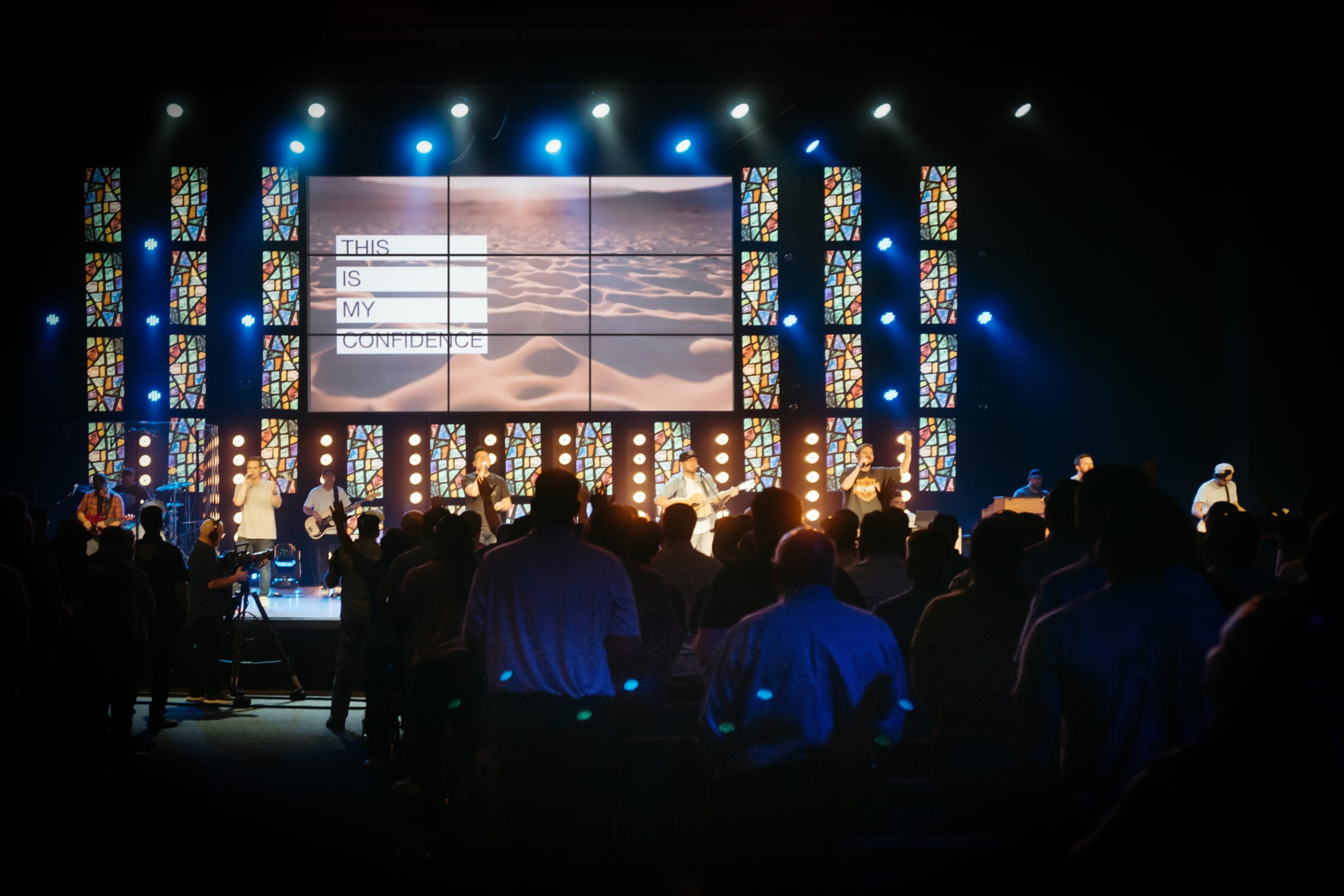
by Brandon White
A videowall is an incredibly impactful and flexible AV design element. Videowalls offer bright, vibrant colors and crisp contrast on an immersive scale that neither video projection nor standard displays can rival. Today’s displays also offer an array of flexible configurations, allowing designers to create not just large-format displays, but screens of any shape or size, with coordinated content that creates stunning dimension and dynamism. Now, we’ve reached a point where the total cost of ownership (TCO) for a videowall system is often lower than that of a comparable projection solution. The time has come for church technology leaders to seriously consider whether their next display system should be a videowall.
Why Videowalls?
When it comes to vibrancy, contrast, and ambient light tolerance, direct view will always beat projection. Videowalls are more intelligible: You don’t have to dim the sanctuary lights to ensure lyrics and scripture are legible. You can also use dynamic stage lighting without interfering with the display. Whether your goal is a more accessible sanctuary where worshippers can always see each other, or an immersive environment that transports the congregation to a place of pure communion, a videowall offers the very best visual experience.
Many churches will question whether this improved experience can justify the cost. Though the price of screens has come down, the initial installation cost of a videowall is still typically higher than a comparably sized projection screen. However, a large-scale projector requires a powerful lamp – an element that consumes a lot of energy, degrades quickly, and must be replaced frequently.
A typical 20K lumen projector consumes about 1600W of power and will last up to 20,000 hours before the lamp dims to half its original brightness. An LED video wall, by contrast, will consume under 50W per panel and last 100,000 hours. Videowalls consume less energy and last up to five times longer: you can pay for the cost difference between a projection system and videowall with just a couple of years’ worth of power bills.
Videowall System Considerations
Videowalls are an excellent option for church tech leaders looking to install or upgrade a sanctuary display system. If you’re considering a videowall, there are several preliminary design and infrastructure decisions to make before you embark.
-
Content
Content always drives display system design. Are you using the videowall to create an immersive ambiance? Will the congregation rely on it for lyrics, readings, closed captioning, etc.? Is the primary purpose image magnification? Will you use the system to bring remote speakers into services? Each of these use cases will inform content resolution, scaling requirements, minimum size, brightness, and contrast recommendations, and more for the system.
-
Resolution, Orientation, and Size
Resolution and size have a direct impact on the system’s cost. For example, you can save money by selecting 1080p displays over 4K. However, image artifacts are more prominent at lower resolutions. The larger the videowall, the more important it is to consider UHD.
The size of the worship space will also inform the minimum appropriate size for a videowall. Using factors, including the type of content, farthest and nearest viewer distance, and viewing angle, you can calculate the appropriate screen size – AVIXA offers a free online tool for this purpose.
Think through your current and future applications carefully, listing sources and resolutions for each: this allows you to create a videowall that will answer your congregation’s needs for the full lifespan of the display.
A videowall is made up of a cluster of interconnected panels, which can be either LED or LCD. These two technologies have different price points, benefits, and applications.
- LCD videowall panels are very similar in appearance and installation to traditional LCD televisions. They tend to cost less upfront than LED panels, though they do consume more power. LCD panels are larger, making for faster installation and easier service. They also feature a high pixel density that’s ideal for close viewing. On the downside, LCD panels have a visible bezel and less flexible configuration options.
- LED videowalls can be built in practically any size, shape, or configuration. LED videowall panels can be bezel-less, allowing the creation of massive, seamless displays. LED videowalls are ideal for large spaces and creative deployments, but they are typically more expensive and require more labor for installation and service than LCD panels.
In general, an LCD videowall is a better choice for informational signage or applications with budget constraints. For large worship spaces, custom configurations, or high-resolution graphics and video, an LED videowall is the preferred recommendation.
Controllers
A controller takes a single source – or multiple simultaneous sources – and divides it into multiple signals shown on each display like interlocking puzzle pieces. Many videowall displays come with some controller functionality built-in, but worship leaders are advised not to rely on it. A dedicated videowall control device will significantly expand your options – and therefore, the value of your system.
A dedicated controller enables customization including third party control integration, screen rotation, scaling, source switching, and multiview. Unless your use case is unusually limited, you’ll want a controller in your system design.
Mounting Hardware
Mounting is an often-overlooked aspect of videowall design – but doing it right can significantly lower your service and installation costs. Fixed mounts are cheaper than flexible – right up until the first service call. When you need to adjust the center panel of a 3X3 videowall, a fixed mount suddenly becomes pretty costly.
Make sure you are using purpose-built videowall mounts, which allow minute horizontal and vertical adjustments. Ideally, look for spring-loaded mounts that allow you to connect and troubleshoot individual panels by extending them out from the wall and then locking them back into place when finished.
Cabling
Though some videowalls do allow local input, most applications necessitate that sources and displays are fairly far apart – especially in multi-source applications. That means you’ll need to give thought to extension technology for your videowall application.
For most house of worship applications, category cable extension, including HDbaseT, is an excellent choice. Cat cable extenders can extend 4K HDMI signals up to 100 meters, sometimes including PoE. Cat cable is relatively inexpensive and easy to install – but make sure you pay careful attention to the cable environment.
Cat cable should always be at least 12 inches from electrical wires, which may be challenging in the tight space behind a videowall. They can also be subject to RF interference from wireless microphones and other devices. In such cases, shielded Cat cable or fiber may be a better choice than unshielded copper.
Build to Last
A videowall can be a powerful – and fiscally responsible – worship space enhancement. It’s critical, however, that worship tech leaders embark on videowall projects with eyes wide open. If they try to save on foundational elements like mounts or cables, they may not achieve the longevity and service cost savings that give videowalls a TCO edge over projection systems.
If you are ready to invest in a videowall for your church, make sure you support it appropriately, With the right foundational technology selections at the outset, you can create a stunning display solution that will serve you for the next decade.

Brandon White is the Director of New Product Development for Vanco and leads the design, engineering, and development of Vanco International’s four AV brands. Brandon’s dad, Larry White, worked with major AV manufacturers for more than four decades, which inspired Brandon to pursue a career in the industry. Since joining Vanco in 2015, Brandon has helped develop nearly 100 products and patented technologies.





